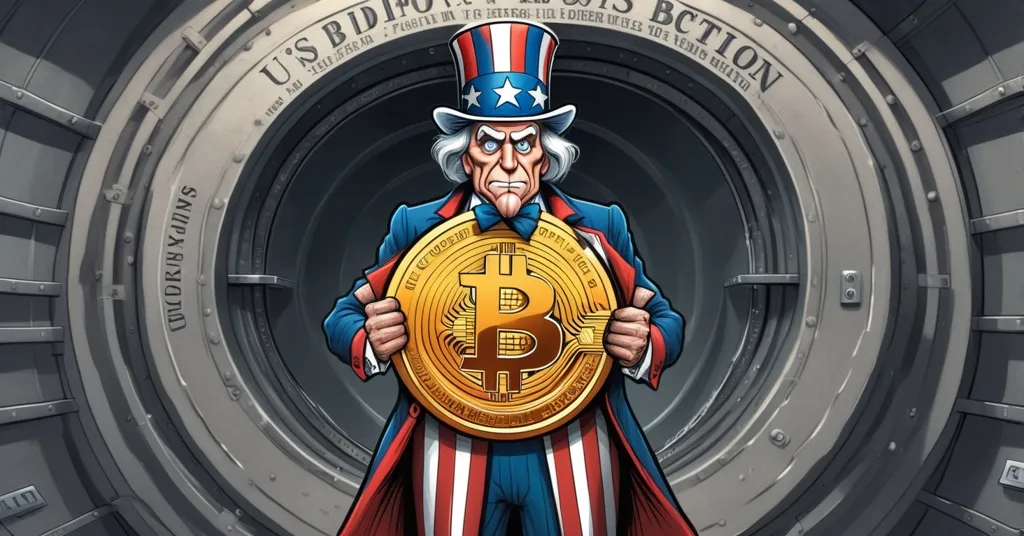Trump Signs Orders to Boost U.S. Bitcoin Reserves: A Strategic Move Explained

U.S. Aims to Bolster Bitcoin Reserves: Trump’s Executive Orders Explained
The Trump administration is ramping up its focus on Bitcoin, with a clear intention to increase U.S. reserves through strategic acquisitions. Bo Hines, the executive director of the presidential council on digital assets, has declared that the U.S. wants to amass as much Bitcoin as possible. This ambition follows President Trump’s signing of two executive orders—one establishing a digital asset regulatory framework and another to audit and potentially expand the nation’s Bitcoin reserves.
- Trump signs executive orders for digital asset regulation and Bitcoin reserve.
- U.S. holds 200,000 BTC, mostly from criminal seizures.
- Bo Hines likens Bitcoin to digital gold.
- Potential loss of U.S. top BTC holder status if DOJ’s motion to return BTC to Bitfinex is granted.
Executive Orders Explained
President Trump has taken decisive action by signing two executive orders on March 6, 2025. The first order creates a digital asset regulatory framework, which is a set of rules to govern the use and management of cryptocurrencies. This framework aims to streamline oversight and ensure the legitimacy of digital assets as financial instruments. The second order establishes a Strategic Bitcoin Reserve and a U.S. Digital Asset Stockpile, signaling the government’s intention to treat Bitcoin as a reserve asset similar to gold. These moves align with Trump’s campaign promise to position the U.S. as the “crypto capital of the world,” a bold statement that could resonate deeply with the cryptocurrency community.
Current U.S. Bitcoin Holdings
The U.S. currently holds approximately 200,000 BTC, a significant portion of which has been acquired through criminal seizures. These include high-profile cases like Silk Road and Bitfinex, where Bitcoin was confiscated due to illegal activities. Bo Hines, at a recent Blockworks event in New York, emphasized the administration’s bullish approach, stating,
“I get asked all the time how much (BTC) you want. Well, that’s like asking a country how much gold do you want? As much as we can get.”
This comparison of Bitcoin to gold isn’t just metaphorical; it’s a strategic alignment that positions Bitcoin as a key asset in the U.S.’s financial arsenal.
Future Challenges and Strategies
Despite the ambitious plans, the U.S. faces potential hurdles. The Department of Justice has proposed returning 95,000 BTC to Bitfinex, which could impact the U.S.’s position as the world’s largest nation-state holder of Bitcoin if the motion is approved in 2026. This situation underscores the delicate balance between accumulating wealth and addressing legal and ethical obligations.
The executive order also authorizes an audit of U.S. BTC holdings and the exploration of budget neutral strategies—those that do not increase the national budget deficit—to acquire more Bitcoin. However, past premature sales of Bitcoin have already cost U.S. taxpayers over $17 billion, highlighting the financial implications of managing these assets. As the U.S. navigates these challenges, it’s crucial to consider the long-term impact on the crypto market and international relations.
Implications and Counterpoints
The establishment of a Strategic Bitcoin Reserve and a U.S. Digital Asset Stockpile could signal a broader shift towards recognizing cryptocurrencies as legitimate financial instruments. This could influence global perceptions and policies regarding digital assets. However, there are valid concerns about the environmental impact of Bitcoin mining, given its energy-intensive nature. Additionally, some critics worry about potential market manipulation as the U.S. increases its Bitcoin holdings.
On the other hand, proponents argue that Bitcoin’s decentralized nature and limited supply make it an ideal hedge against inflation and a valuable addition to national reserves. The U.S.’s strategy could encourage other nations to follow suit, potentially leading to increased global adoption and stability in the crypto market. Discussions on platforms like Reddit and Quora reflect the diverse opinions on the impact of Trump’s Bitcoin policy.
Key Questions and Takeaways
What actions has President Trump taken regarding Bitcoin and digital assets?
President Trump has signed two executive orders: one to establish a digital asset regulatory framework and another to audit and possibly increase U.S. Bitcoin reserves.
How much Bitcoin does the U.S. currently hold?
The U.S. currently holds approximately 200,000 BTC, sourced mainly from criminal seizures.
What did Bo Hines say about U.S. Bitcoin acquisition plans?
Bo Hines stated that the U.S. aims to acquire as much Bitcoin as possible, likening it to how a country views gold.
What could affect the U.S.’s position as the largest nation-state BTC holder?
The U.S. might lose its top position if the Department of Justice’s motion to return 95,000 BTC to Bitfinex is granted in 2026.
What is the source of the U.S.’s Bitcoin reserves?
The U.S.’s Bitcoin reserves primarily come from criminal seizures, including those from Silk Road and Bitfinex.
As the U.S. continues to navigate the complex landscape of digital assets, the journey ahead will be fraught with challenges and opportunities. Will the U.S. maintain its lead in the global Bitcoin race, or will it stumble over legal and ethical hurdles? Only time will tell, but one thing is clear: the stakes are high, and the world is watching.



